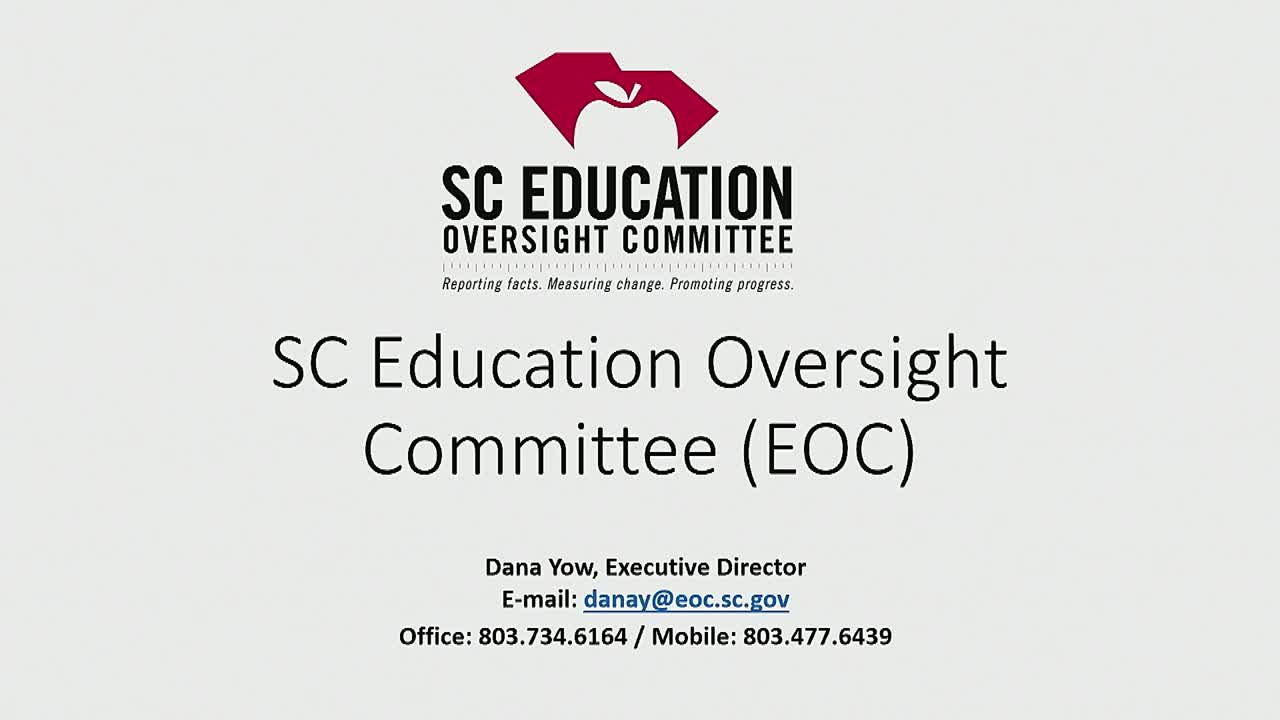Education Oversight Committee director highlights graduation gains, flags chronic absenteeism and rural teacher recruitment
April 30, 2025 | 2025 Legislative Meetings, South Carolina
This article was created by AI summarizing key points discussed. AI makes mistakes, so for full details and context, please refer to the video of the full meeting. Please report any errors so we can fix them. Report an error »

Dana Yao, executive director of the Education Oversight Committee, told the House Education and Public Works Committee that the EOC approves statewide content standards and accountability measures and evaluates state-funded programs such as full‑day 4K.
Yao said the committee issues annual school report cards that are legislatively mandated to be released by Oct. 15 and produces special studies and an education data dashboard at dashboardsc.sc.gov. She said the EOC’s evaluations of the state’s full‑day 4K program “show that that program does work for 4 year olds.”
The EOC director presented 2024 figures showing an on‑time high‑school graduation rate of 85.4 percent. Yao and committee members emphasized a separate measure of college‑and‑career readiness. In describing readiness metrics, Yao said the state uses multiple indicators — college entrance exams, rigorous coursework such as AP/IB and industry certifications — to determine whether graduates leave high school with an immediately useful credential.
Committee members pressed for clarity on how graduation and readiness figures relate. Representative Bradley (committee member) restated his understanding of the data and asked: “Am I to understand an 85% graduation on time rate and 30% of that group is college and career ready.” Yao affirmed the distinction between the on‑time graduation rate and the subset who meet college‑or‑career metrics. She and members agreed the gap between graduation and readiness is a central policy concern.
Yao also summarized recent and planned work by the EOC: periodic evaluations of the rural recruitment initiative (EIA funds of about $7.6 million currently supporting a menu of roughly 15 incentives, including housing and mentoring), a study of alternative modes of instruction that found face‑to‑face delivery produced stronger achievement results in the last review, and an ongoing focus on chronic absenteeism. She said chronic absenteeism affected roughly 20–23 percent of students in 2022–23 (students missing about 10 percent of the school year) and that the EOC has completed focus groups with students and is just receiving parent focus‑group results.
Committee members raised additional topics during Q&A: the EOC’s cyclical review of the accountability system, turnover of teachers in rural districts (Yao said she did not have a ready figure but offered to provide it), and the EOC’s small staff (she said the agency has roughly eight FTEs). Yao encouraged committee members to use the EOC’s public dashboards for district‑level drilldowns and to submit nominations for the committee’s membership and cyclical review.
Yao said the committee issues annual school report cards that are legislatively mandated to be released by Oct. 15 and produces special studies and an education data dashboard at dashboardsc.sc.gov. She said the EOC’s evaluations of the state’s full‑day 4K program “show that that program does work for 4 year olds.”
The EOC director presented 2024 figures showing an on‑time high‑school graduation rate of 85.4 percent. Yao and committee members emphasized a separate measure of college‑and‑career readiness. In describing readiness metrics, Yao said the state uses multiple indicators — college entrance exams, rigorous coursework such as AP/IB and industry certifications — to determine whether graduates leave high school with an immediately useful credential.
Committee members pressed for clarity on how graduation and readiness figures relate. Representative Bradley (committee member) restated his understanding of the data and asked: “Am I to understand an 85% graduation on time rate and 30% of that group is college and career ready.” Yao affirmed the distinction between the on‑time graduation rate and the subset who meet college‑or‑career metrics. She and members agreed the gap between graduation and readiness is a central policy concern.
Yao also summarized recent and planned work by the EOC: periodic evaluations of the rural recruitment initiative (EIA funds of about $7.6 million currently supporting a menu of roughly 15 incentives, including housing and mentoring), a study of alternative modes of instruction that found face‑to‑face delivery produced stronger achievement results in the last review, and an ongoing focus on chronic absenteeism. She said chronic absenteeism affected roughly 20–23 percent of students in 2022–23 (students missing about 10 percent of the school year) and that the EOC has completed focus groups with students and is just receiving parent focus‑group results.
Committee members raised additional topics during Q&A: the EOC’s cyclical review of the accountability system, turnover of teachers in rural districts (Yao said she did not have a ready figure but offered to provide it), and the EOC’s small staff (she said the agency has roughly eight FTEs). Yao encouraged committee members to use the EOC’s public dashboards for district‑level drilldowns and to submit nominations for the committee’s membership and cyclical review.
View full meeting
This article is based on a recent meeting—watch the full video and explore the complete transcript for deeper insights into the discussion.
View full meeting